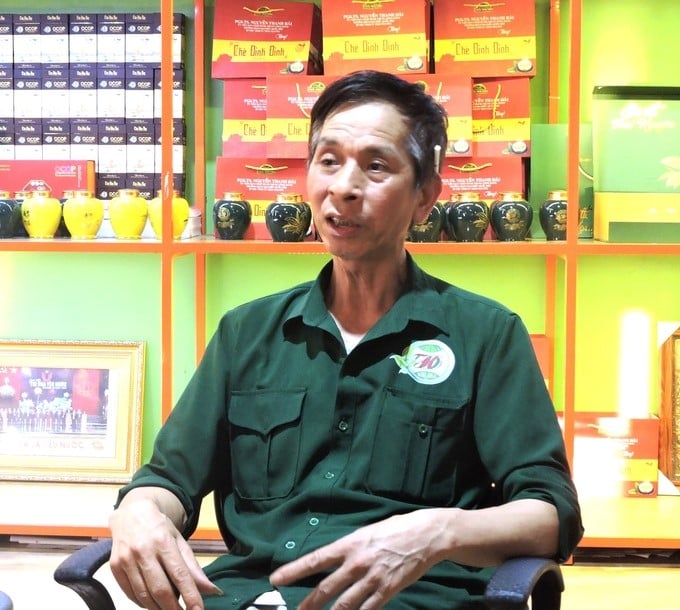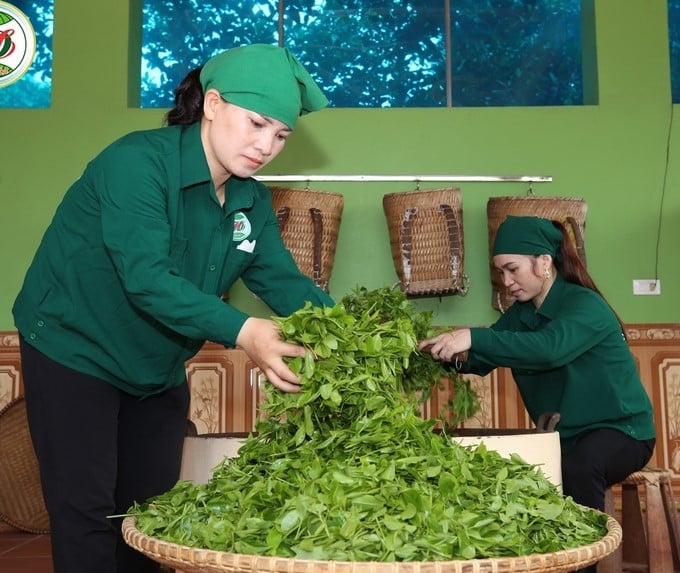June 18, 2025 | 07:36 GMT +7
June 18, 2025 | 07:36 GMT +7
Hotline: 0913.378.918
June 18, 2025 | 07:36 GMT +7
Hotline: 0913.378.918

Hao Dat Tea Cooperative. Photo: Hoang Anh.
Along the road from Thai Nguyen City to Tan Cuong commune are yellow-green panels standing out on the gentle midland tea hill of Hao Dat tea cooperative, a place to enjoy free tea. Hao Dat cooperative is proud of the national 5-star OCOP product, the Tan Cuong tea culture space, the community tourism site of Tan Cuong tea cooperative union, etc. Our colleague in Thai, Nguyen, said that in recent years, strangers coming to Tan Cuong and intentionally or just accidentally passing by Hao Dat cooperative can stop there and enjoy a delicious pot of tea while sipping on some peanut candies also made from green tea. All are completely free. This is a unique culture that has been formed in the land of tea by pioneers and pioneer cooperatives.
In a wooden house built in the style of Tay people's stilt houses at the beginning of Tan Cuong commune, Ms. Dao Thanh Hao, Director of Hao Dat Tea Cooperative, meticulously brewed a teapot to invite guests. That is Tom Non tea, a kind of tea honored as the first 5-star OCOP product of Thai Nguyen province in June 2021. Tea water shakes with a yellow-green color, and the green rice flavor is fragrant. It is just early in the morning of summer, and the weather in the city is very hot, but as soon as we arrive here, the climate is clearly different—cool and mild. Eating a piece of peanut candy and sipping a cup of tea is really nothing like this pleasure.

Mr. Pham Tien Dat. Photo: Toan Nguyen.
My forefathers used to be the most land-rich people in Tan Cuong. Pouring more tea to invite guests, Mr. Pham Tien Dat, husband of Ms. Hao, thoughtfully reminisced. There was a time when nearly half of the area of Tan Cuong tea was the land of the librarian Pham Van Hoc, my grandfather. According to the old people's stories, in 1928, a group of the Pham family's brothers from Vu Ban, Nam Dinh, came to reclaim this land. Thanks to the virtues of diligence, hard work, and familiarity with the hardships of the people in the lowlands, they gradually built up a sizeable land area associated with the locality’s traditional tea profession. They are the richest and most prominent people in the region, and their family’s tea brand is also the most famous in the region. Tan Cuong tea from the Pham family is well known in many places. There was a time when the number of merchants temporarily residing in their house was up to dozens of people.
At the beginning of the resistance war, Tan Cuong was a stop on an important traffic route bringing revolutionary cadres from ATK2 to Viet Bac. The house and property of librarian Pham Van Hoc were the "red address" for the revolution to rely on. Being a generous person and believing in the revolution, the old man made great contributions both in material terms and in building the establishment to hide cadres. Certificates and rewards for the merits of librarian Pham Van Hoc are still kept in the Pham family church in Tan Cuong.
Unfortunately, that glory and wealth finally died out during the land reform period. Despite many contributions to the revolution, Mr. Pham Van Hoc still could not escape the situation of the time. The land was expropriated; houses and all property were redistributed to displaced people and people working for new businesses. The descendants of the Pham family each had only a few thousand square meters of land left to grow tea, divided on average like many other families. By the time of the cooperative, many of them had left; the rest were stuck in their hometowns, clinging to the tea profession during the decline. Mr. Dat was originally a soldier. Returning home at the right time before Doi Moi, many things were bound, so the land was vast, but the people of Tan Cuong were mostly poor. The ambition to restore the traditional tea profession of Mr. Dat’s family seemed hard until he got married to Ms. Hao in the Y Na tea village. On the first day of being the daughter-in-law of the Pham family, the girl from Y Na village told her husband that if her husband wanted to develop Tan Cuong tea's name, she and her husband alone couldn't do it; they had to create a linkage to go far together.

Ms. Pham Thanh Hao, Director of Hao Dat Tea Cooperative. Photo: Van Viet.
The cooperation group, then cooperative, was established. Initially, the cooperative only included seven households, and the raw material area was limited to a few scattered tea gardens, but after only a few years, Hao Dat became the largest cooperative in the Tan Cuong tea area. With more than 50 official members and hundreds of affiliated households, approximately thousands of tons of specialty tea are sold to the market each year, generating revenue in the tens of billions of dong. The entire area of linkages and production processes is applied science, technology, digitization, etc. The achievements are all thanks to the inspiration of a woman born in 1964. There are even many people who jokingly liken Central Highlands coffee to Mr. Dang Le Nguyen Vu and Tan Cuong tea to Ms. Dao Thanh Hao. Of course, all comparisons are lame, but what Ms. Hao has done with the ‘first famous tea’ is also very proud.
Leading us between the picturesque tea hills, Ms. Hao honestly shared that everything today is like a dream. In the past, mobilizing people to join the cooperative was only done with the desire to build the Tan Cuong tea brand that the forefathers left behind in a decent and kind way. And perhaps that kind path led to today’s Hao Dat linakge chain.
60% of Tan Cuong tea goes to the market through cooperatives. Each plot of land of the member and affiliated households is digitized, from the raw material area to the processes of production and processing, all complying with VietGAP standards or in the direction of organic methods. The cooperative’s members "go to work by timekeeper and pay by card".

Tea-making profession in Tan Cuong today. Photo: Toan Nguyen.
Hao Dat is the first cooperative in Tan Cuong to respond to digital transformation, participate in e-commerce platforms, invest in a system of modern processing factories, install machinery and equipment, apply modern technology, etc. "In the past, tea farmers could only produce a few tea butters with sweat and tears, but today, with more than 70% of machines automated, the processing capacity of fresh bud tea has also increased to 2-3 tons/day. The production is much easier and more efficient than before", shared a farmer woman resting her hands. “You see, the tea-making people now are not only hardworking but also knowledgeable about science, the market, and the culture of Tan Cuong tea too,” said Ms. Hao.
Translated by Huyen Vu Thu
/2025/06/17/3942-2-143243_548.jpg)
(VAN) Recently, in Sweden, the Secretary of the Binh Dinh Provincial Party Committee presented the Investment Registration Certificate for the 'Polyester Fabric Recycling Complex' project to SYRE Impact-AB Company.
/2025/06/12/3721-2-202745_83.jpg)
(VAN) TH made an impression at Seoul Food 2025 with its line of natural beverages, paving the way for Vietnamese food products to enter the South Korean market.

(VAN) Soc Trang's success in rice exports stems from a strategy of developing fragrant and specialty rice cultivation areas and standardizing production toward low-emission practices.
/2025/06/11/1311-5-120811_839.jpg)
(VAN) The pig farming industry is facing the challenge of comprehensive restructuring to meet requirements for quality, safety, traceability, and market expansion both domestically and for export.

(VAN) Vietnam considers participating in ALGROALBA in order to expand agricultural production, coordinate the assessment and effective exploitation potential land.
/2025/06/05/5314-1-184727_407.jpg)
(VAN) From seemingly worthless fish scales and skin, enzymes and lactic ferments can transform by-products into peptides, opening a sustainable, effective business direction and elevating Vietnamese seafood.

(VAN) TTC AgriS and IFC signed a strategic partnership to develop a sustainable agricultural value chain, aiming to achieve the Net Zero target by 2035.